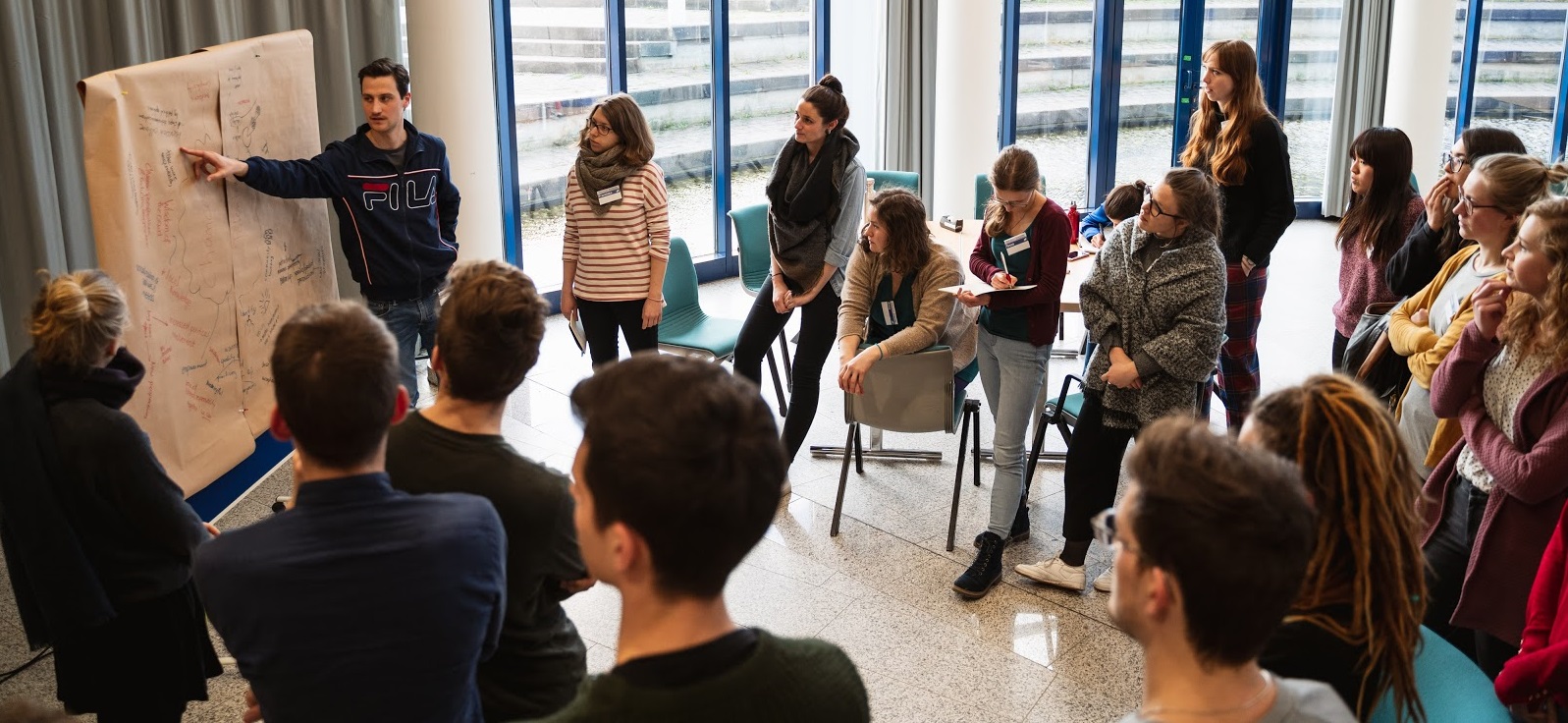
The oikos Winter School 2019 explored a range of topics from Megacities and Smart Cities to new energy and transportation concepts to civic participation. In this interactive blog prepared by Janina Hoffmann, one of the participants of the winter school and oikos communications and marketing working group member, you can take a closer look at the topics covered by inspiring speakers and passionate participants.
The shaping of us
This story is relevant to you, as urban space is about your living space. Central to this topic are the questions: How do we want to live? How do we imagine our living spaces? How can we shape our habitat? I joined this year’s Winter School to find answers to these questions and learn about tools that can help to improve our environment for the better.
“We shape our buildings, afterwards our buildings shape us.” Winston Churchill
Creating SUSTAINABLE CITIES is foremost about creating LIVEABLE CITIES – cities that are suited for us – humans, not for cars or for economic interests. Seems logical, but I feel that the human-centered perspective often gets overlooked. To design cities where humans can flourish, I am convinced, we need to give people the tools and opportunities to co-create their own homes, their own street, their own city, their own country. Most of all, we have the responsibility to look for them and I, you, we need to take the lead in shaping our environment, our future and above all us.
What I took away from the Winter School with respect to increasing the living quality is the creation of space and infrastructure that are in line with our needs. It entails good division of public spaces where we can come together and socialize and private areas which should be green safe havens where we can connect with nature and ourselves.
Find out more in the following sections about how to involve more people in sustainable projects, how to make a difference in a city and how to create liveable urban spaces.
[toggle title=”How can we involve more people in making our cities more sustainable?”]

A key to successful participation
Dr. Jan-Hendrik Kamlage: “It’s about getting people involved in establishing good and trustful relationships, which foster a communicative space for sharing ideas, arguments and criticism. Based on this relation, a structured and demand-tailored process can be implemented and professionally facilitated with balanced information.”
A keypoint for a sustainable transition – civil participation
Tessa Elliott : “I got reminded again that it is up to everybody to help create the future we want to live in and that every little step counts, moreover that most actions e.g. civil participation projects like Bochumboltz have to start with a small step and grow from there.
Civil participation is a key point for a transition to a sustainable future because politicians need reminders for what society wants and for decisions that need to be taken. Sometimes one bottom up action may seem very small but it can be an important piece for the puzzle to our future. Likewise, it is very important that each organisation or movement has some key people who have the overview over what needs to be done.”
Initiating involvement though a social media campaign – #einehandvollMüll:

Patrick and Leon from BochumBoltz: “Witten is one bad example of environmental pollution. In all places you find a lot of carelessly thrown away garbage, especially plastic waste. For that reason, we started a social media campaign, called #einehandvollMüll to animate, nominate and enthuse as much people as possible to join our initiative and our daily cleaning. Just one hand of rubbish a day – each of us!
One solution to get citizens involved is to sensitize a lot of them for pollution right in front of their houses.”
Project ingredients: Believe in it, think big, take time, take part and use a pinch of trend

Tessa Elliott: “During the week I saw that a project needs people believing in it, thinking big, time, patience and luck e.g. the guys from BochumBoltz said that right now as actions like plogging (a mix of trash picking and jogging) meet the current trend, their project of trash picking combined with kids playing football has gotten a boost. I want to work further on the project, support other initiatives and encourage people to also take action even if they feel they cannot give a lot of time, they can still make an impact.”
Show people what your concern is really about. Did you know – cycling is about creating a liveable city!

Mark Wagenbuur, bicycling expert from the Netherlands: “A city that is good for cycling is automatically a city that is good for people. There is less noise, less pollution more space for people. Most people would like their children to live in a safe and healthy environment, it is easier to engage people when they realise it is not just about cycling but about improving their living environment.”
Action, Action, Action! – everyone can contribute
 Sarah Scheck: “In the city I live I see a lot of things from a different perspective now. For instance, I see it more with the eyes of a ‘traffic watcher’ who critically observes the big car challenge and searches for ideas for a better bicycle infrastructure.
Sarah Scheck: “In the city I live I see a lot of things from a different perspective now. For instance, I see it more with the eyes of a ‘traffic watcher’ who critically observes the big car challenge and searches for ideas for a better bicycle infrastructure.
We just need action, action, action, especially on a political level. Nevertheless, there is enough scope for every individual to change something on a small scale, e.g. together with other people in your own urban district. I believe this is primarily important as everyone can contribute.”
How can you get involved in the urban development process in your cities? Join public discussions and submit suggestions for improvements!
 Anke Unverzagt: “Planning drafts are publicly discussed and decided by the municipal council. Then there is an obligatory publication period anyone can submit suggestions for improvements or objections. Within the Kronsberg project a participation process is established especially for the inhabitants of the existing district. Regularly events are organized to inform and get feedback regarding current planning.”
Anke Unverzagt: “Planning drafts are publicly discussed and decided by the municipal council. Then there is an obligatory publication period anyone can submit suggestions for improvements or objections. Within the Kronsberg project a participation process is established especially for the inhabitants of the existing district. Regularly events are organized to inform and get feedback regarding current planning.”
Projects cannot be implemented without citizens – without us!
Tessa Elliott: “As we learned that the people play a key role how a city develops, it is more than ever important to be conscious about our own behavior and to interact with the other citizens to exchange ideas (many still need to be found).
I also got reminded that it is important to connect with people working in sustainable urban development e.g. when they are trying to reach out to include the citizens, their opinions and ideas in the planning. The municipalities and city planners, of which we got to meet some people at the winter school, are trying to reach out and some projects/ideas cannot be implemented without the citizens behind it.”
How we can stay motivated – starting with one street at the time
Sarah Hündgen: “Overall, the examples and ideas we learned about made it very clear, that there is no “one size fits all” solution, and that sustainable cities do not emerge from one single initiative.
While this might seem frustrating at first, I personally find it rather motivating as this also means that every single change can contribute its part to the bigger picture. Individuals or small groups of city activists are not as powerless as they might perceive themselves when thinking of “changing a whole city”.
Starting with a neighborhood has the potential to inspire others, changing the city one street at a time.”
[/toggle]
[toggle title=”What does it take to create sustainable cities?”]
It takes three ingredients to create sustainable cities. They need to be liveable, resilient and resource efficient
Dr. Kerstin Krellenberg: “Developing existing and newly emerging cities in a way that they provide livable, resource efficient and resilient living conditions for all people is of highest importance in order to transform our world towards sustainability.
There is no single solution towards sustainability.
Creating sustainable cities is by no means an easy task. Different urban developing paths are prevailing which are framed by diverse political, institutional, economic, climatic, demographic, cultural etc. settings. This means there is no single solution towards sustainability.
I am therefore convinced that considering citizens’ behaviour, needs, fears and perceptions in urban sustainability transformations will need to take centre stage.”
What does it take to create liveable cities?
The key factors in establishing a good cycling infrastructure or rather
creating a liveable city.
Mark Wagenbuur, the cycling expert, shows by example how we can create liveable and safer cities: “Cycling cities are less polluted, less congested, people who cycle are healthier and happier. Active travel changes people’s lives and their environment for the better. Cycling infrastructure is cheap to build and cycling is cheap for the person doing it. Cycling only has advantages and lots of them.”
What does it take to for a successful energy transition?
Prof Dr. Andreas Wagner, expert for building physics states explains what is essential for a successful energy transition and why we need to focus on the building sector as well as the heating energy.
The building sector’s share of germany’s total end energy consumption is approximately 40% out of which 80% is heating energy. The maximum heating energy demand occurs during periods when solar contributions are small. Consequently, energy storage and a variety of different renewable resources are important prerequisites for a successful transition. Furthermore, we have a large existing building stock. Buildings built before 1980 consume about 90% of the energy of the whole building sector. Without stringent measures to decrease the CO2 emissions of existing buildings we will not reach our climate targets for 2050.
First, we have to more than double the refurbishment rate for buildings to significantly increase energy efficiency of the building stock. This is not only a technological, but even more an economical, political and societal challenge.
Second, different technologies for heating on the basis of renewable energies have to be pushed forward, including heat pumps (i.e. electrifying the heating sector) as well as biomass as a storable resource. Here, cities can play an important role by shifting the focus from single buildings to whole neighbourhoods for integrated energy efficiency and supply solutions.
What are building-integrated photovoltaics (BIPV) and why can they make cities more sustainable?
Dr. Björn Rau: “Building-integrated photovoltaics is the integration of electricity-generating elements into the building skin. Photovoltaic modules become also construction elements of the building and vice versa a roof, a façade, a sunblind or even a window also produces electricity directly from sunlight. BIPV generates electrical energy there, where it is consumed without any climate-damaging emissions.”
[toggle title=”What are the biggest challenges cities are facing? And how do we need to address them?”]
We need to address them transdisciplinary
Dr.Kerstin Krellenberg: “Urban areas are where more than 55% of the world population resides, which creates many challenges as well as opportunities.
Cities are highly complex and present many societal challenges, which calls for integrative perspectives and systemic considerations in order to develop feasible solutions. This again cannot be achieved within disciplinary boundaries and without considering the knowledge and interest of the many societal actors involved in urban development.
Here, inter- and transdisciplinary research can play a decisive role in bringing disciplines, actors and sectors together and to work jointly on real-world problems and transformations towards urban sustainability.”
Franziska Adams: “Studying in several large cities in Germany, USA and Denmark confronted me with urgent challenges, such as the lack of affordable housing and the dominance of cars over pedestrians/bikers. The key take-away from the Winter School for me is that sustainable development is so much more than just focusing on cars or housing, but combining several disciplines and considering state-of-the-art cultural, political and technical situations, including coincidences which are sometimes more effective than planned efforts.”
We need to embrace solutions that are already out there
Dr Björn Rau: “There is a very high potential for BIPV (e.g. Germany >30%) to contribute significantly to the energy supply of a society. Unfortunately, BIPV still does not play the role that it could do. One main reason is the missing knowledge in the group of the initial stakeholders of construction or renovation projects about potential and already technical and creative possible solutions. Another aspect is the complex world of regulatory frameworks which comes into play if solar modules meet the world of construction.
Moreover, further technical solutions have to be develop to provide cost-effective, multifunctional construction elements meeting the demands of architects and planners.”
Prof. Dr. Andreas Wagner: “Coupling building-internal and external (neighborhood) energy infrastructures offers a large potential to increase the share of renewable and decentrally generated energy on the basis of a levelized building energy efficiency standard.”
We need to know the major lever
Janina Hoffmann: “Prof. Dr. Wagner’s clever wordplay “Keine Energiewende ohne Wärmewende. Keine Wärmewende ohne warme Wände.” (No energy transition without heat energy transition. No heat energy transition without warm walls) gave me a new perspective on the challenge of the energy transition. Even though I knew that you can reduce your heating costs immensely with each degree.”
We need to drive change in cities
Sarah Scheck: “We are currently undergoing a crucial and most likely radical change referring to our economical and societal development, for instance when we look at topics such as globalization, digitalization, shift of power on a global level just to name a few. I feel the strong need of the population to exert influence on the direction of those developments in order to not lose human factor but rather take the opportunities that are there by focusing on the common good. Cities will be the places in which most people can be reached and most of those approaches and changes can be undertaken.”
Ban Ki-moon, Ex-UN General Secretary: “Our struggle towards sustainability will be won or lost in cities”
We need to act neighbourly
Sarah Hündgen: “Cities are the places we live in, the places we settle down, the places our everyday social network evolves. Thus, cities heavily impact our quality of life – maybe even more than any other single factor. This is why I believe that to “leave no one behind” in our global journey towards a sustainable future (as the SDGs claim), it is crucial to act local: on a neighbourhood and city level.”
We need to get the ball rolling
BochumBolzt: “We want to combine the great social power of soccer with environmental protection. Our Goal is the liberation of our city from all types of garbage, especially plastic waste. Our Tool – small neighbourly soccer fields!”
We need to take action
Tim Belau: “In an urban setting where buildings and roads already exist, you might think everything is set. But when people come together and build bottom-up movements a city can develop, road after road building after building. To start the transformation we need to discuss what we a livable and sustainable city looks like. Solutions are out there already, but we have to pressure people in charge to implement them also in our home towns. I want to care about my surroundings. I want to connect with my neighbours. I want to change my city because honestly there are just too many cars in Berlin.”
And action: What do you want to address in your city? What can you change in your city?
[/toggle]
[toggle title=”Testimonials: What’s the oikos Winter School all about?”]
[layerslider id=”42″]
[/toggle]
[toggle title=”People behind the winter school”]

The oikos Winter School is organized by the members of the oikos chapter University of Witten/Herdecke since 2007 each year.
A special thanks goes to the amazing organizing team of 2019 and a extra thanks goes to Johannes Buldmann for capturing this wonderful Winter School experience with his camera. Thank you all for welcoming us like some old friends at the station, for the extremely well thought through, prepared programm with practice-oriented activities, with outstanding experts in the field of urban development as well as specialities like energizers and reflection breaks. You established a place you don’t want to stop learning.
Thank you for making this incredible experience possible for us.
A huge thanks goes to all the experts for taking part at the winter school, providing us with such valuable input and for contributing their expertise to this interactive blog story.
The last thank you goes to all the inspiring, marvellous and activism charged participants. You made this an unforgettable journey for me. It was hard for me to say goodbye and not wanting to found a (winter) school to think, plan and implement projects together with you to make our living more sustainable. For me, a liveable city starts with living with people which I can grow and flourish with.
[/toggle]
Experience in Pictures







